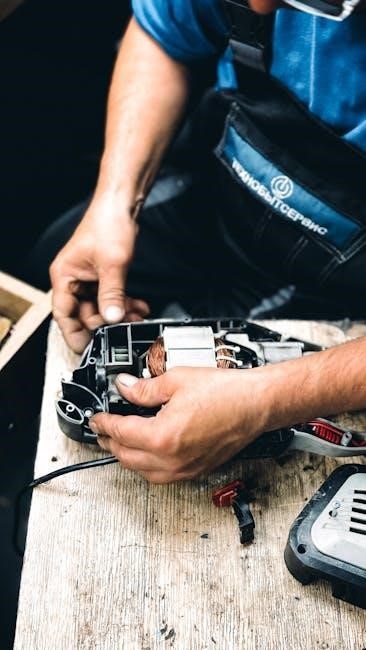Nevada Quitclaim Deed PDF⁚ A Comprehensive Guide
A Nevada quitclaim deed is a legal document used to transfer ownership of real estate in Nevada. It’s a simple document that allows the grantor to transfer any interest they may have in a property to the grantee‚ without making any warranties about the title’s quality. This guide will delve into the details of Nevada quitclaim deeds‚ covering their purpose‚ key components‚ differences from grant deeds‚ and how to fill out‚ file‚ and use them effectively.

What is a Nevada Quitclaim Deed?
A Nevada Quitclaim Deed is a legal document that transfers ownership of real estate in Nevada. It allows the current owner (the grantor) to convey their interest in a property to another party (the grantee). Unlike a warranty deed‚ which guarantees the title’s quality‚ a quitclaim deed does not provide any warranties about the property’s ownership or encumbrances. It simply transfers whatever interest the grantor possesses‚ regardless of its validity or completeness.
The grantor essentially relinquishes their claim to the property‚ transferring any existing interest they have. This makes it a useful tool for various situations‚ including⁚
- Transferring property between family members
- Clearing title issues
- Resolving ownership disputes
However‚ it’s crucial to remember that a quitclaim deed does not guarantee clear title. Therefore‚ it’s essential to conduct proper title searches and obtain legal advice before using a quitclaim deed‚ especially in complex real estate transactions.
Purpose of a Nevada Quitclaim Deed
Nevada Quitclaim Deeds serve various purposes‚ each aiming to transfer ownership or interest in real estate within the state; The primary function is to convey the grantor’s existing interest in a property to the grantee‚ regardless of its nature or validity. This makes it a versatile tool for various real estate transactions‚ such as⁚
- Transferring Property Within Families⁚ Quitclaim deeds simplify property transfers between family members‚ like spouses‚ parents‚ or siblings‚ often used for inheritance purposes or to establish joint ownership.
- Resolving Title Issues⁚ When title disputes arise‚ a quitclaim deed can be used to clear any conflicting claims or remove encumbrances from the property title‚ creating a clearer ownership record.
- Clearing Liens and Encumbrances⁚ A quitclaim deed can release liens or encumbrances‚ such as mortgages or judgments‚ held against the property‚ transferring ownership to the grantee free of these obligations.
- Transferring Property to a Trust⁚ A quitclaim deed can transfer ownership of property to a trust‚ allowing for efficient asset management and estate planning purposes.
However‚ it’s important to note that using a quitclaim deed does not guarantee clear title. The grantor’s interest may be limited or subject to undisclosed issues. Therefore‚ thorough due diligence and legal advice are crucial before utilizing a quitclaim deed‚ especially in complex real estate transactions.
Key Components of a Nevada Quitclaim Deed
A valid Nevada Quitclaim Deed must contain specific essential components to ensure legal validity and clarity. These components define the transfer of ownership and provide a comprehensive record of the transaction. Here are the key elements that should be included⁚
- Grantor Information⁚ The deed must clearly identify the grantor‚ the person or entity transferring ownership‚ with their full legal name and address. This information ensures accurate identification and accountability.
- Grantee Information⁚ Similar to the grantor‚ the grantee’s full legal name and address must be included in the deed. This clearly identifies the recipient of the property interest.
- Property Description⁚ A detailed legal description of the property being transferred is crucial. This description should include the address‚ lot and block numbers‚ and any other relevant details that accurately identify the property.
- Consideration⁚ While not always required‚ stating the consideration for the transfer‚ which can be monetary or non-monetary‚ adds clarity to the transaction. This section specifies the value exchanged for the property interest.
- Granting Clause⁚ This clause formally states the grantor’s intent to relinquish their interest in the property and transfer it to the grantee. It should be clearly worded and unambiguous.
- Signature and Notarization⁚ The grantor’s signature must be present and notarized‚ confirming their intent and authenticity. Notarization adds legal weight and verifies the grantor’s identity.
- Date⁚ The date of execution must be included‚ confirming the time of the transfer and providing a reference point for legal purposes.
These essential components ensure a legally sound quitclaim deed that accurately reflects the intended transfer of property interest in Nevada.
Difference Between a Quitclaim Deed and a Grant Deed in Nevada
While both quitclaim deeds and grant deeds are used to transfer real estate ownership in Nevada‚ they differ significantly in their implications and legal protections. Understanding these differences is crucial when choosing the appropriate deed for your specific circumstances.
A quitclaim deed conveys only the grantor’s interest in the property‚ without any warranties about the title’s quality. Essentially‚ the grantor transfers whatever rights they possess‚ but doesn’t guarantee the title’s validity or freedom from encumbrances. This makes quitclaim deeds suitable for simple transfers between family members or for clearing up title issues‚ but not for transactions where a clear title is essential.
On the other hand‚ a grant deed provides greater assurance to the grantee. The grantor‚ in this case‚ warrants that they have a good and valid title to the property and that it is free from encumbrances. This implied warranty offers a higher level of protection for the grantee‚ making grant deeds preferable for most real estate transactions‚ especially those involving significant financial investments.
Therefore‚ while a quitclaim deed can be used to transfer property‚ it’s crucial to understand its limited legal protection. Grant deeds‚ offering stronger warranties‚ are generally preferred for ensuring a clear and unencumbered title transfer.
How to Fill Out a Nevada Quitclaim Deed
Filling out a Nevada quitclaim deed requires accuracy and attention to detail. While you can download a free template online‚ seeking legal advice before proceeding is highly recommended. Here’s a general guide on completing the deed⁚
- Identify the Grantor and Grantee⁚ Clearly state the full legal names and addresses of both the grantor (the person transferring the property) and the grantee (the person receiving the property).
- Property Description⁚ Provide a detailed legal description of the property‚ including its address‚ lot and block numbers‚ and any other relevant identifiers. Consult with a professional to ensure the description is accurate and complete.
- Consideration⁚ State the consideration for the transfer‚ which can be a monetary value‚ a gift‚ or other agreed-upon exchange.
- Signatures and Notarization⁚ The grantor must sign the deed in the presence of a notary public. Ensure that all signatures are clear and legible.
Remember‚ this is just a general guide. It’s crucial to ensure all information is accurate and legally compliant. Seek legal assistance from a qualified attorney to avoid potential legal complications.
Where to Find a Nevada Quitclaim Deed Template
Finding a Nevada quitclaim deed template is relatively straightforward. Several online resources offer free downloadable templates‚ allowing you to create and print your deed. However‚ be cautious when using free templates‚ as they may not be up-to-date with the latest Nevada legal requirements. Consider the following sources⁚
- Legal Document Websites⁚ Websites dedicated to legal documents often provide free templates for various forms‚ including quitclaim deeds. These websites typically offer a range of options‚ including customizable templates‚ making it easier to adapt the document to your specific situation.
- Government Websites⁚ While Nevada state government websites may not directly provide templates‚ they often link to resources for legal forms and documents. Check the Nevada Secretary of State website or the Nevada Real Estate Division website for potential leads.
- Real Estate Professionals⁚ Real estate agents‚ brokers‚ and attorneys specializing in property transfers can often provide access to Nevada quitclaim deed templates. Contacting a professional in your area can provide valuable guidance and ensure you use the correct and legally compliant template.
Always verify the source of the template and ensure it aligns with current Nevada laws. Consulting with a legal professional is highly recommended to ensure the accuracy and validity of the deed before using it for any property transfer.
Filing a Nevada Quitclaim Deed
Once your Nevada quitclaim deed is completed and signed‚ you must file it with the appropriate county recorder’s office. This process officially records the transfer of ownership and ensures the deed is publicly accessible. The specific steps for filing may vary slightly depending on the county‚ but generally involve the following⁚
- Gather Required Documents⁚ In addition to the completed quitclaim deed‚ you may need to provide identification‚ proof of ownership‚ and payment for filing fees. Contact the county recorder’s office to confirm the specific requirements.
- Submit the Deed⁚ Deliver the deed and any necessary supporting documents to the county recorder’s office in person or by mail. Some counties may offer online filing options. Ensure the deed is properly notarized and signed by all parties involved.
- Pay Filing Fees⁚ Filing a quitclaim deed incurs a fee‚ which can vary depending on the county. Check with the recorder’s office for the current fee schedule.
- Receive Confirmation⁚ Once the deed is filed‚ the county recorder’s office will provide you with confirmation. This confirmation serves as proof that the deed has been officially recorded and is now part of the public record.
Filing the quitclaim deed is essential for ensuring the transfer of ownership is legally recognized and protects your rights to the property.
Important Considerations When Using a Quitclaim Deed
While a quitclaim deed can be a useful tool for transferring property‚ it’s crucial to be aware of its limitations and potential risks. Here are some important considerations before using a quitclaim deed⁚
- No Warranties⁚ Unlike a warranty deed‚ a quitclaim deed doesn’t guarantee the grantor’s ownership or the quality of the title. It simply transfers any interest the grantor has‚ regardless of its validity or potential encumbrances.
- Potential Title Issues⁚ A quitclaim deed may not clear existing liens‚ easements‚ or other encumbrances on the property. It’s essential to conduct a thorough title search to understand the property’s history and potential issues before using a quitclaim deed.
- Legal Advice⁚ Due to the complexities involved‚ it’s highly recommended to consult with a qualified real estate attorney before using a quitclaim deed. A lawyer can ensure the deed is properly prepared and executed and advise on any potential risks or consequences.
- Tax Implications⁚ Transferring property through a quitclaim deed may have tax implications for both the grantor and the grantee. Consult a tax professional to understand the potential tax liabilities associated with the transfer.
By understanding the nuances of quitclaim deeds and seeking professional advice‚ you can make informed decisions regarding their use and mitigate potential risks.
Legal Advice for Nevada Quitclaim Deeds
Due to the complexities and potential risks associated with quitclaim deeds‚ it’s strongly recommended to seek legal advice from a qualified real estate attorney before using one. A lawyer can provide valuable guidance and ensure the deed is properly prepared and executed‚ protecting your interests and minimizing potential legal issues. Here’s why legal advice is crucial⁚
- Title Examination⁚ An attorney can conduct a thorough title search to uncover any existing liens‚ encumbrances‚ or other issues that may affect the property’s ownership. This helps avoid potential legal disputes and ensure the transfer is clear and valid.
- Proper Deed Drafting⁚ A lawyer can ensure the quitclaim deed is drafted correctly‚ following Nevada’s specific legal requirements and accurately reflecting the intended transfer of ownership. This reduces the risk of errors or ambiguities that could lead to future complications.
- Understanding Legal Implications⁚ A real estate attorney can explain the legal implications of using a quitclaim deed‚ including potential risks‚ tax consequences‚ and any other factors that may impact your transaction. This ensures you understand the full scope of the transfer and make informed decisions.
- Negotiation and Dispute Resolution⁚ If any disputes arise during the process‚ a lawyer can represent your interests and negotiate a favorable outcome. They can also assist in resolving any legal issues that may arise after the deed is executed.
Consulting with a lawyer ensures you have a smooth and legally sound transfer of property while minimizing potential risks and complications.





